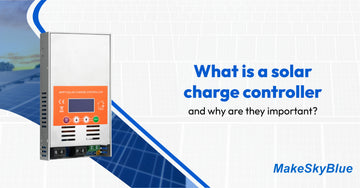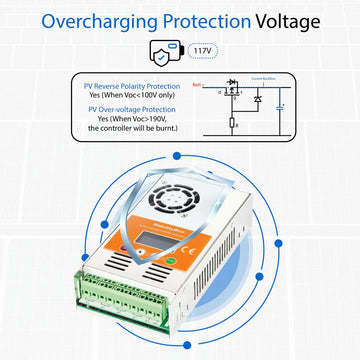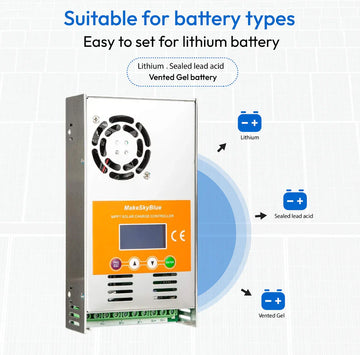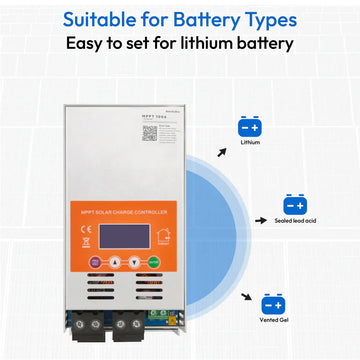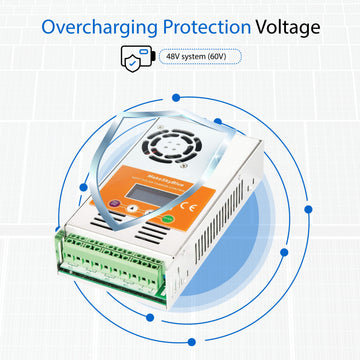A Maximum Power Point Tracking (MPPT) solar charge controller is a sophisticated device that optimizes the power output from your solar panels to charge your batteries more efficiently. Unlike traditional Pulse Width Modulation (PWM) controllers, MPPT controllers continuously monitor and adjust the voltage and current from the solar panels to ensure they operate at their maximum power point, regardless of changing sunlight conditions.
How Does an MPPT Charge Controller Work?
Solar panels have a specific voltage at which they produce maximum power, known as the Maximum Power Point (MPP). This point varies with sunlight intensity and temperature. An MPPT controller tracks this MPP and adjusts the system to operate at this optimal point, converting excess voltage into additional current to charge the battery more efficiently. This dynamic adjustment leads to more effective energy harvesting and storage.
Advantages of MPPT Over PWM Controllers
-
Higher Efficiency: MPPT controllers can increase charging efficiency by up to 30% compared to PWM controllers, especially in conditions where sunlight is less than optimal.
-
Better Performance in Variable Conditions: They adapt to changing sunlight and temperature, maintaining optimal charging conditions.
-
Flexibility in System Design: MPPT controllers allow for higher voltage solar arrays, reducing the need for extensive wiring and minimizing energy loss over long distances.
-
Faster Battery Charging: By efficiently converting excess voltage, MPPT controllers can charge batteries more quickly, ensuring a reliable power supply.
Ideal Applications for MPPT Controllers
MPPT controllers are particularly beneficial for:
-
Large Off-Grid Systems: Such as homes, farms, or remote installations where maximizing energy efficiency is crucial.
-
Systems with High Voltage Solar Panels: When using multiple panels in series, MPPT controllers ensure the system operates at peak efficiency.
-
Areas with Variable Weather Conditions: In regions where sunlight intensity fluctuates, MPPT controllers adjust to maintain optimal charging.
Selecting the Right MPPT Controller
When choosing an MPPT charge controller, consider the following:
-
System Voltage: Ensure the controller matches your battery bank's voltage (e.g., 12V, 24V, 48V).
-
Current Rating: The controller should handle the maximum current your solar array can produce.
-
Features: Look for additional features like Bluetooth connectivity for monitoring, LCD displays for real-time data, and compatibility with various battery types.
Efficiency Gains with MPPT Controllers
MPPT controllers can increase charging efficiency by up to 30% compared to PWM controllers, especially in conditions where the solar panel voltage is significantly higher than the battery voltage. This efficiency gain is particularly noticeable during periods of low sunlight or when the system is operating at partial capacity.
Sizing Your MPPT Charge Controller
Properly sizing your MPPT charge controller is crucial for system performance and safety. The controller's current rating (measured in amps) should correspond to the maximum current your solar array can produce. For instance, if your solar array generates 600W and you're using a 12V battery system, the current would be:
Therefore, a 50A MPPT charge controller would be appropriate. It's advisable to select a controller with a slightly higher current rating to accommodate potential future system expansions.
Battery Voltage Considerations: 12V, 24V, or 48V?
The choice between 12V, 24V, and 48V battery systems impacts both system efficiency and design.
-
12V Systems: Common in small-scale applications like RVs and boats. They are straightforward to design but may require larger wire sizes due to higher current.
-
24V Systems: Offer reduced current for the same power output, allowing for smaller wire sizes and reduced losses over longer distances.
-
48V Systems: Ideal for larger installations, providing even lower current and allowing for more extensive solar arrays with reduced voltage drop.
Battery Voltage vs. Panel Voltage
When designing your system, ensure that the solar panel voltage (Vmp) is higher than the battery voltage to facilitate efficient charging. For example, a 12V battery system would benefit from panels with a Vmp of 18V or higher. MPPT controllers can handle higher input voltages, allowing for longer series strings of panels, which can reduce wiring costs and minimize voltage drop.
Oversizing Your Solar Array
Oversizing your solar array—installing more panels than the controller's nominal rating—can be beneficial, especially in regions with abundant sunlight. For instance, some MPPT controllers can handle up to 200% oversizing, meaning you can connect more panels than the nominal rating without exceeding the controller's input limits. However, it's essential to ensure that the controller's maximum voltage (Voc) is not exceeded.
Comparison Table: 12V vs. 24V vs. 48V Systems
| Feature | 12V System | 24V System | 48V System |
|---|---|---|---|
| Current (A) | Higher | Lower | Lowest |
| Wire Size | Larger | Smaller | Smallest |
| Voltage Drop | Higher | Moderate | Lowest |
| Suitable Panel Vmp | 18V–22V | 36V–44V | 72V–88V |
| Ideal Applications | Small-scale setups | Medium-scale setups | Large-scale setups |
Conclusion
Selecting the appropriate MPPT solar charge controller involves understanding your system's requirements, including panel voltage, battery voltage, and desired efficiency. By carefully considering these factors and properly sizing your components, you can ensure a reliable and efficient solar power system.
For more detailed information and product recommendations, visit the full article on Clean Energy Reviews.
FAQs
What is the main difference between MPPT and PWM controllers?
MPPT controllers track the maximum power point of solar panels, adjusting voltage and current for optimal efficiency, while PWM controllers simply match panel voltage to battery voltage, which can be less efficient.
Can MPPT controllers be used with any solar panel?
Yes, MPPT controllers are compatible with various solar panel configurations, but it's essential to ensure the panel's voltage and current ratings match the controller's specifications.
Do MPPT controllers work in cloudy conditions?
Yes, MPPT controllers adjust to varying sunlight conditions, optimizing power output even under cloudy skies.
Are MPPT controllers more expensive than PWM controllers?
Generally, MPPT controllers are more expensive, but their increased efficiency can lead to cost savings over time.
How do I size an MPPT controller for my system?
Consider the total wattage of your solar array and ensure the controller's voltage and current ratings are compatible with your system's specifications.

